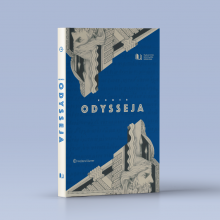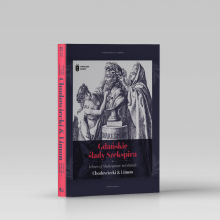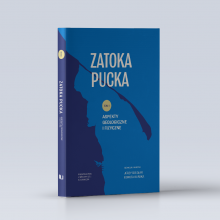April 23rd is World Book and Copyright Day. The University of Gdańsk Publishing House publishes around two hundred scientific and popular science titles every year. In May, a new university bookshop-café will be officially opened, where the academic community will be able to get acquainted with new titles over a cup of hot coffee or tea.
We are talking with mgr Joanna Kamień, Director and Editor-in-Chief of the University of Gdańsk Publishing House, about the book publishing and promotion process.
Marcel Jakubowski: - What is the process of book creation at the University of Gdańsk Publishing House?
Joanna Kamień: - Usually an author comes with a ready-made book. But this doesn't mean that it goes straight to print. This is only the beginning of a long, intensive process in which a group of people is involved. A very important part of this team is the editor, whose task is to correct the book in terms of language, spelling and structure. It is also his or her responsibility to check with the author any omissions or ambiguities and to correct them. Only after this first stage of editing does the book go to the DTP operators who assemble it.
The next stage is proofreading, which is usually carried out by the same person as the editor. After re-reading the already assembled book, the editor sends his corrections to the typesetter. At the same time, he accepts the author's corrections from the proofreader. The editor and typesetter work on the book file until they are satisfied that there are no errors in the book and that it is technically correct and ready for printing. In parallel with the editorial work, work continues on the graphic design of the publication, including the cover. The cover is designed by graphic artists who receive the order and all instructions from the editor in charge at the publishing house.
The finished files with the book inside and the cover are sent to a printing house. In the case of our publishing house, we are lucky that the printing house belongs to the University of Gdańsk and is located in the same building as the publishing house, so we can control everything on an ongoing basis. After printing, the book is distributed.
- What are the most frequent corrections you make to your books?
- These are very different comments. Everyone writes differently and the level of preparation of authors for writing a book varies. Some authors are very correct and tidy. There is not much problem with their books, although there is no publication that does not need editing. It's a myth that if someone writes well, the book is basically printable. Even if you're an editor and an author at the same time, you can't put your book into print without editing by someone who has a distance to it. You always need that external reader. The author is not able to catch certain errors himself, even if he were very meticulous and knew all the rules of the Polish language. Everyone has their obsessions and habits that are difficult to escape from.
There are many errors: grammatical, syntactical, stylistic, punctuation and also factual. Sometimes a book is written in a hurry or over a long period of time. In such situations, it is difficult to remember everything and standardise everything. Sometimes they simply lack a fresh perspective on the book, on which they have spent many months, and sometimes years, working.
I personally make sure that the structure of the book is well thought out and coherent. Sometimes this important element needs to be discussed with the author and a different division into chapters or their order needs to be suggested. It all depends on the author. When we work with someone for the umpteenth time, this process is easier. The author knows how to prepare.
With people who are submitting their first book, it's very important to know that we have good intentions. We don't want to point out the author's mistakes, we just want to help them through the process so that in the end their book is as perfect as possible. Substantively, the author is certainly the best in his field and in what he has written. The editor is also supposed to be good and meticulous in his work, and the two should work together in such a way that the result is the best possible book.
Cover of the book Jewish Theatre in Gdańsk 1876-1968 by dr Mieczysław Abramowicz
- The covers of the titles that came out from your publishing house are very diverse. On the one hand, the minimalist cover of the book about Jewish theatre by dr Mieczysław Abramowicz, and on the other hand, the colourful 'packaging' of the sociological study of football fans by dr hab. Radosław Kossakowski, prof. UG. What was your guiding principle when choosing the cover?
- The cover should in some way reflect the spirit of the book and refer to what is inside. Our graphic designers receive guidelines from the editors or authors. Often the cover is the work of the graphic designer alone. This was the case with prof. Kossakowski's sociological study on football fans.
Cover of the book Soccer fans. A sociological study by dr hab. Radosław Kossakowski, prof. UG
As far as the graphic design of dr Abramowicz's book is concerned, it was my idea to refer to a specific theatre poster included in this publication. Personally, I like elegant and economical designs that are at the same time very refined. For example, they can work very well with typography or single elements that correspond with the whole book. However, we don't always go in this direction. Sometimes we also choose projects that are more tongue-in-cheek or very bold and expressive. As an example, I recommend the cover of the book Blade Runner. On the Laws of Quasi-Man, edited by prof. dr hab. Kamil Zeidler. It really is a very strong, very colourful concept.
Cover of the book Blade Runner. On the Rights of the Quasi-Human edited by prof. dr hab. Kamil Zeidler
Unlike some trade publishers, we don't stick to one cover design. Each book is individual. I think it's very important for an author that their work stands out from thousands of other publications. The cover is the first element we pay attention to. As a reader myself, I have picked up some books simply because I was intrigued by their cover art. Although sometimes this has proved deceptive.
- So actually, with a well-designed book, we can judge it by its cover because it reflects what's inside?
- Certainly, a cover designed with an idea and in a thoughtful way is a good harbinger of the content of a book, but not its 'summary'. I have sometimes bought books for their covers, not only because of the potential quality of the book or the interest in its content but also to be able to communicate better with graphic designers, to use the covers of these books and the way they are prepared as inspiration for projects we do in the publishing house. The computer is not able to render the final product, especially if we want to refine the cover polygraphically. You can paint it on the screen but you cannot fully render the relief, the texture of the paper or hot-stamping.
- We have the text, we have the cover. What are the next steps in book promotion?
- The initial promotion begins when the book goes to print. Then we post it in previews on our website and social media. Then depending on what promotional opportunities we have, this process looks different. Our books are very diverse. We publish both strictly scientific and popular science items. Sometimes we have several titles that deal with a similar topic and are aimed at students or a small group of scientists who deal with this discipline. In such cases, promotion outside the Internet is more difficult and consists mainly of sending copies to professional journals, in which review notes could appear.
The most interesting is when the book is so universal and its topic so catchy that we can organise an author meeting. Such events promote the book, the subject and the author himself. We usually organise them in cooperation with the Library of the University of Gdańsk. But if we co-publish a book with another cultural institution, we plan these promotions together. In the case of the book about Jewish theatre by Mieczysław Abramowicz, the co-publisher was the National Museum in Gdańsk, where the author works. The first promotion took place in the synagogue. Another way of promoting the book is through radio broadcasts. We are in regular contact with Radio Gdańsk and Radio Tok FM, where our authors are often guests.
- Do people read popular science books?
Cover of the book Understanding the world of numbers prof. dr hab. Mirosław Szreder
- They read and they also buy them. We have a few such popular science books that we continue to print, promote and organise meetings with their authors. Sędziowie i niewolnicy. Szkice z filozofii prawa by prof. dr hab. Jerzy Zajadło we are publishing already for the fifth time. Mądrość chińskich aforyzmów by prof. dr hab. Kamil Zeidler was our best-selling item last year. Books on Hans Memling's Last Judgement written by, among others, prof. dr hab. Beata Możejko and dr hab. Jerzy Jankau, prof. GUMed, are very popular. Prof. Hanna Dymel-Trzebiatowska's Filozoficzne i translatoryczne wędrówki po Dolinie Muminków are an absolute hit. Similarly, the aforementioned Blade Runner: O prawach quasi-człowieka has sold very well since its publication. Popular science books are a very good investment for a publishing house and I think they also give a lot of satisfaction to the authors themselves.
- The number of e-books in Poland is growing every year. Do you also see an increase in sales of books in this form, or do people interested in science and scientists still prefer paper?
- In the first year of the pandemic, sales of our e-books tripled compared to the previous year. Fewer people were leaving home, so they were looking for a book that was at their fingertips.
On the other hand, I wouldn't speculate that the paper book is disappearing. Some books cannot be fully experienced in digital form. I am talking about album publications. Currently, on the initiative of the Rector, prof. Piotr Stepnowski, we are preparing an exhibition at the UG entitled 'Gdańsk Traces of Shakespeare: Chodowiecki & Limon'. One of its elements will be an extensive catalogue and I cannot imagine it being available only as an e-book. It is probably also difficult for an author to derive satisfaction from his work when he only receives a pdf file after the official launch of the book. Unfortunately, since the pandemic, prices on the paper market have been rising exponentially. At first, there was a problem with the mere availability of paper, and now its cost has tripled. Until now, publishing a book in black and white, digitally printed, was no luxury and everyone could afford it. Now the cost of printing can be an obstacle.
- What are the University of Gdańsk Publishing House's immediate plans connected with this changing book market?
- Regardless of the rise in paper prices, we will certainly continue to print books. But we need to think about their circulation and how quickly the electronic version of the book will appear on the market. Very often, the digital launch is postponed until the first print run is exhausted. If we are reducing the number of paper copies, then it would be advisable for the book to appear on bookstore shelves and in e-book format at the same time. We will also consider whether every book has to be published in paper form for distribution. Perhaps it is sufficient to publish it as an e-book with a minimum print run?
Cover design of the book 'Freedom Written after Yalta' by prof. dr hab. Stefan Chwin
- What books from the UG Publishing House will we see on bookstore shelves soon?
- A very interesting and unusual book is Homer's Odyssey translated by the late prof. dr hab. Wacław Dawidowicz. We are preparing a third edition of this translation, which has been beautifully illustrated and we want it to have a bibliophilic character. We can afford it thanks to financial support from the sponsor of this edition: Głuchowski, Siemiątkowski, Zwara law firm, and especially the support of attorney Andrzej Zwara. As the two previous editions of Odyssey were published by Wolters Kluwer, we received a licence from them and we are co-publishing it on the rights of this licence. At the beginning of June, during a scientific conference devoted to prof. Dawidowicz, the book will have its promotion. We are also planning to organise a promotional meeting with the participation of an actor who will read fragments of the Odyssey. At the end of this week, the aforementioned extensive bilingual catalogue of the exhibition Gdańskie ślady Szekspira / Echoes of Shakespeare in Gdańsk: Chodowiecki & Limon, edited by prof. dr hab. Piotr Stepnowski and I will go to print. As far as popular science titles are concerned, we are also planning a book by prof. Beata Możejko on the stories of the most extraordinary princesses of the Middle Ages. In June, a collection of unpublished essays by prof. dr hab. Stefan Chwin, Wolność pisana po Jałcie, will have its premiere, which we are publishing together with the Provincial and Municipal Public Library in Gdańsk. And for the Shakespeare Festival in Gdańsk, which takes place at the end of July and the beginning of August, we are preparing the edition of the late prof. dr hab. Jerzy Limon's columns, which were previously published in episodes in the 'Prestiż' monthly. In autumn, on the initiative of prof. dr hab. Kamil Zeidler, we will also publish a translation of a book by the Italian author, commander of the Carabinieri for the Protection of Cultural Heritage, Roberto Riccardi, entitled Detective dell'arte. Carabinieri in the service of preserving cultural heritage, for the translation of which we received a grant from the Italian Ministry of Foreign Affairs. The publishing plans for this year also include excellent scientific books, including the eagerly awaited and for months now prepared for print three-volume edition on the Puck Bay, edited by dr hab. Dorota Burska, prof. UG, and prof. dr hab. Jerzy Bolałek.
In mid-May, the Faculty of Social Sciences will also launch a University Bookstore, which will be run by the UG Publishing House. Apart from buying books, you will be able to drink coffee, tea or browse through books there. Our books will be on sale, as well as those published by other academic and popular science publishers, but also literary and art publishers. Electrical sockets have been installed on the seating stairs that have been built here, so you will be able to sit with your laptop or phone and just work. The idea behind this place is to create a space where academics and students can sit down with a good drink and work or read, surrounded by books.
- Thank you for the interview.
- Thank you.



